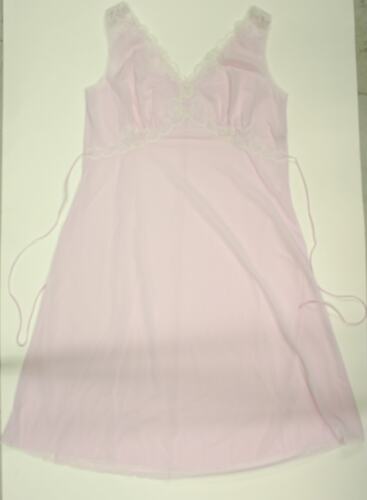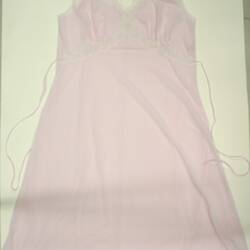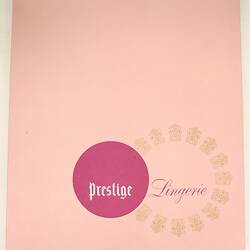Summary
Lilac synthetic nightdress in original cardboard box, made under the label of Prestige Lingerie. It was purchased in the 1960s.
Prestige had a large factory in Donald Street, Brunswick, manufacturing `quality' women's hosiery and lingerie from the 1920s until around 1970, when the business closed. The donor's aunt, Ruby Postance, worked for Prestige from the late 1940s until its closure, producing machine-sewn lingerie.
Physical Description
Knee-length lilac nightdress with lace trim around edges and neckline. Synthetic material with white lace. In rectangular box with a pink lid, featuring white, gold and purple text.
Significance
The last 30 years has seen a dramatic decline in the clothing and textile industry which use to operate throughout Melbourne due mainly to the lowering of tariffs on imported clothing. Australian companies have found themselves unable to compete with cheaper imports, mainly from Asia, due to the higher costs involved, particularly in regards to labour. Many Australian brands have either closed up shop or amalgamated with other firms, and many that survived have transrferred their manufacturing plants offshore.
The Prestige items date from a time when there were a number of large clothing manufacturing plants dotted around Melbourne, particularly in the Northern inner city, from Footscray, to Abbotsford, Brunswick and Collingwood. Prestige had a large factory in Donald Street, Brunswick, manufacturing 'quality' women's hoisery and lingerie from the 1920s until around 1970, when the business closed. The donor's aunt, Ruby Postance, worked for Prestige from the late 1940s until its closure, producing machine sewn lingerie. The reference books were used to show the positioning of the lace decoration of each piece of lingerie she made, and goes someway to show the skill involved in being a machinist. The collection compliments the industrial sewing machines collected from the Gloweave factory. The finished pieces are good examples of the output of a former well known Melbourne company.
The Buckley and Nunn pattern catalogue is a good example of the marketing tools used by a Melbourne Department store, whose building is now occupied by David Jones, and illustrates the popularity of home sewing during the 1950s. The Singer pattern is an unusual type of pattern, not currently represented in the collection, which was aimed at the youth market in the 1960s, who had drifted away from home sewing due to cheap and ephemera nature of youth clothing, and an increase in the number of females in full time work. The pattern tried to make home sewing as easy and as foolproof as possible.
While there is no particular story to accompany the memorandum, it is a highly interesting object. Rarely to we have the opportunity to represent absence in the collection; in this case, people who planned or tried to migrate and then did not come. We can only speculate as to what happened in this case - did Mr Hopkins decide to return to England, thereby making it unnecessary for his family to join him? Was there a parting of the ways in the relationship between husband and wife? The letter is also invaluable for illustrating migration processes at this time - a period for which we have very little in the collection. It documents the formation of bureaus and offices in the various states which publicised state resources and provided information on opportunities and occupations for new settlers (particularly on the land) - in this case the Advertising and Intelligence Bureau (originally, presumably, the Immigration, Intelligence and Labour Bureau attached to the Lands Department in Victoria, 1906). The memo also records the procedural relationship between the Melbourne office and the Emigration Commissioner for Victoria in London, and suggests that, despite Federation, national policy was still unclear and states were still competing against one another for migrants. It illustrates the processes of nomination and assistance, in the pre World War I years particularly encouraged via such schemes as the Closer Settlement assisted land packages.
More Information
-
Collecting Areas
Home & Community, Working Life & Trades, Clothing & Textiles
-
Acquisition Information
Donation from Mrs. Beryl Neate, 09 Sep 2003
-
Date Purchased
-
Inscriptions
Box lid: 'Prestige Lingerie/Prestige/ND 429/NIGHTDRESS/LILAC/36 BUST/1/12 DOZ'.
-
Classification
-
Category
-
Discipline
-
Type of item
-
Keywords


